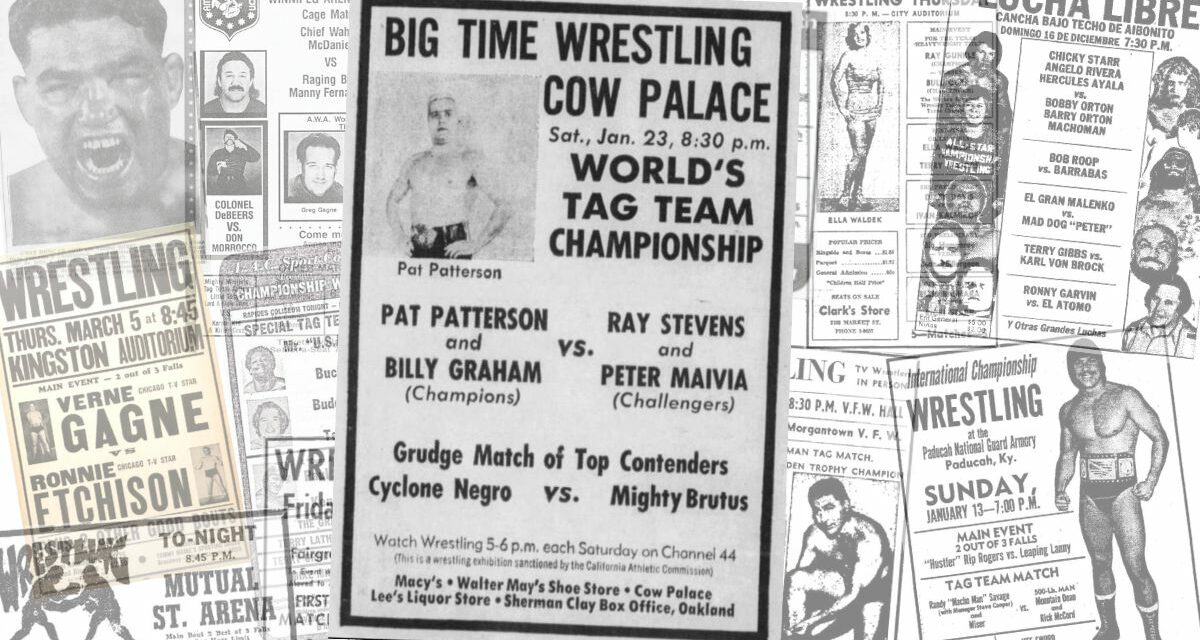With the recent death of “Superstar” Billy Graham, it seems only fitting to tackle a card from his illustrious career for the latest Card Exam. I chose a very early match in the Bay Area — Daly City, to be precise — for promoter Roy Shire at the famed Cow Palace. Here’s the lineup:
January 23, 1971, at the Cow Palace in Daly, CA
- Pepper Martin defeated Bill White
- Masa Saito defeated Earl Maynard
- Mighty Brutus defeated Ciclón Negro
- Rocky Johnson & Tony Parisi defeated Kinji Shibuya & The Professional
- Peter Maivia and Ray Stevens defeated Pat Patterson and Billy Graham (c) 2 falls to 1 for the NWA World Tag Team Titles (San-Francisco-Version)
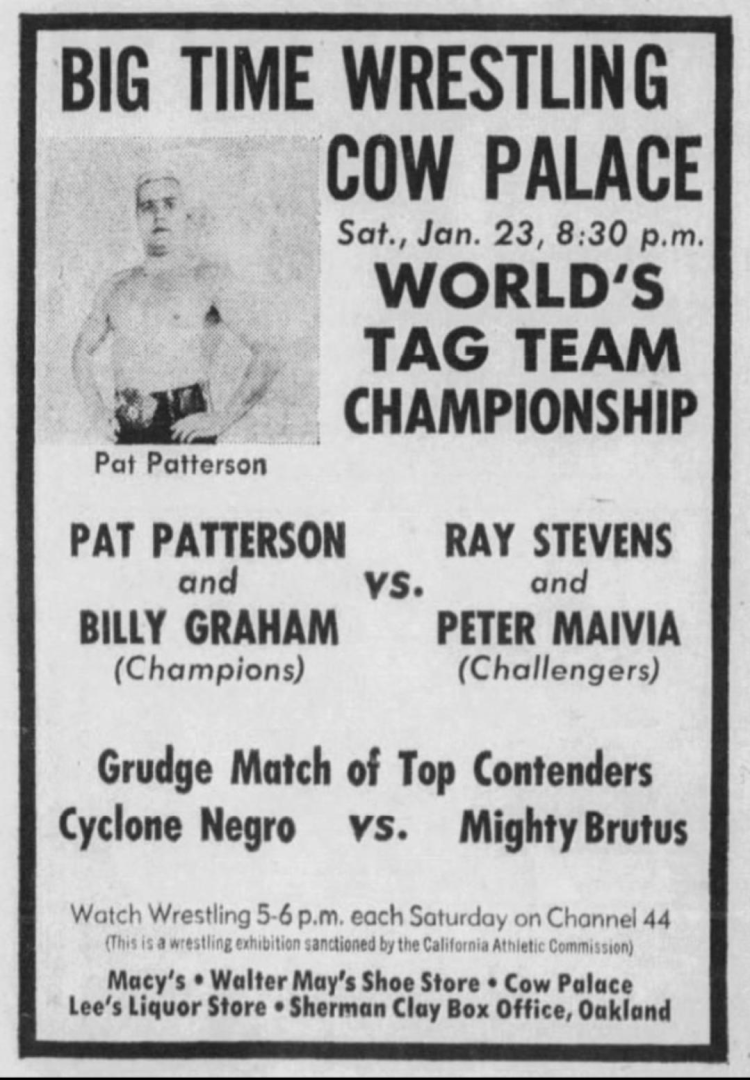
As mentioned, this card emanated from the historic Cow Palace arena in Daly City, just a short trek from San Francisco. The venue, formerly the California State Livestock Pavilion, hosted far more than just livestock auctions, with the 16,000+ seat arena also home to the Golden State Warriors of the NBA, the San Jose Sharks of the NHL until the team moved to a new arena in San Jose, and Big Time Wrestling under the banner of the NWA and promoter/wrestler Roy Shire.
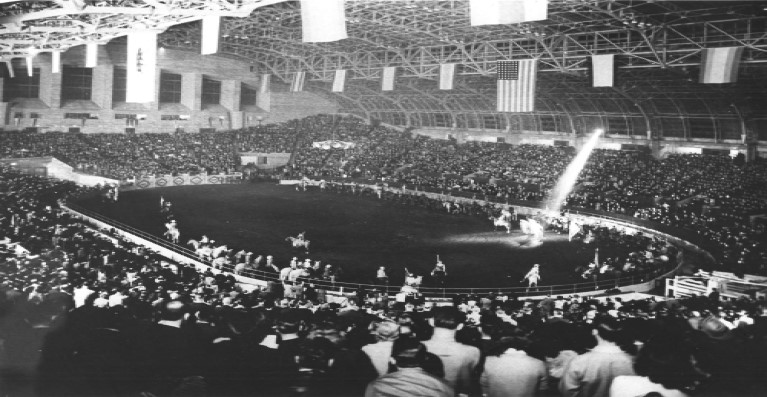
The Cow Palace.
The opening contest saw Hamilton, Ontario’s own Pepper Martin, defeated Bill White. White, as described in his Slam obituary as a “journeyman wrestler and cribbage champion,” was a long-time fixture in the wrestling business, competing in pretty much every territory you can imagine. White was known as a “carpenter” in the wrestling business, meaning he was responsible for building up the big named talent by doing everything in his power to turn a talent into a star – and a star into a superstar.
Martin, for his part, was a celebrated wrestler, actor, and long-winded storyteller. Born in Hamilton as Howard Martin, he lied about his age to join the Navy, before turning to athletics, first with the Hamilton Tigers and then in the squared circle. While he consistently found work early on, his ring name (the same as his real name) held him back – something he learned from Fritz von Erich (Jack Adkisson) on a drive from Cleveland to Buffalo.
Martin recalled the conversation in a Slam article by the one-and-only Greg Oliver covering Pepper Martin: the Wrestling Years:
I’ll never forget the conversation. “Pepper, you’ve got to change your name. Howard Martin is not a good wrestling name. Your problem is you don’t think you’re as good as all the other guys that are working. You’re just as good a worker as they are. Why don’t you change your name to Pepper Martin? The name could really mean something. It’ll help you psychologically. Pepper Martin was a famous baseball player and he’s in the Hall of Fame, so why not capitalize on that name?” That was it. That’s how I got the name Pepper Martin.
Pepper Martin is probably best remembered for his acting work. Getting his start in Angels from Hell in 1968, he would appear in countless films and television series, including I Dream of Jeannie, Bonanza, Superman II, TJ Hooker, and more.
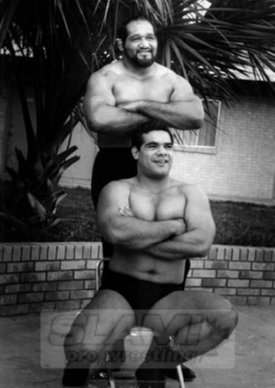
Ciclón Negro and Omar Atlas in Texas in 1968.
Next up is Mighty Brutus and Ciclón Negro. Ciclón Negro is a name you often see during the 1960s and ’70s, winning multiple local, state, and regional titles in a 28-year career. Born Ramon Eduardo Rodriguez in Venezuela, he was another gym rat bodybuilder (this card is loaded with them) that “loved the business, and he loved the power to get the people to scream; It was in his blood,” as recalled by Omar Atlas (Omar Mijares) on Rodriguez’s death in late 2013. Rodriguez’s career had actually taken off overseas, wrestling in Spain, France, Belgium, England, Germany, and Italy before being scouted and brought into Texas by Black Guzman in 1960.
While Ciclón Negro is a forgotten name for most fans, his name still resonates with the greats of the sport. “Cyclone Negro was another very talented individual and one of the nicest guys you’d ever want to meet,” wrote Terry Funk in his autobiography. “He always kept his body in great shape and had one of the greatest, most expressive faces I’ve ever seen. I mean, he had the greatest face in the business. It made him a perfect heel. He wasn’t hideously ugly; he just looked like one mean son of a bitch!”
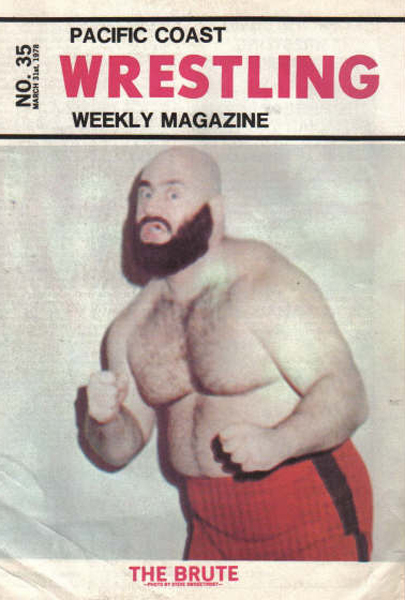
Mighty Brutus is probably a name you aren’t familiar with – and don’t worry – neither was I. But the man who played the character had another name that rings a bell with fans of wrestling on the Superstation: Bugsy McGraw.
Mike Davis was an Indiana-born wrestler who grew up on The Bruiser and got his start with the Sheik in Detroit. His early career was a mashup of names and territories, with Davis working as The Skull, The Brute, Mighty Brutus, The Big O, and more in territories as varied as JWA and Jim Barnett’s WCW in Australia, and Stampede, Florida, Georgia, the Dusek’s All-Star Wrestling in Nebraska, and in Northern California for “Professor” Roy Shire. Of note, Mighty Brutus would have his head shaved by Ray Stevens in a two-out-of-three-falls hair match for the United States title just two months later in Sacramento.
Earl Maynard also features on this card, and, again, the Superstar’s body resembles the hulking musculature of the former “Mr. Universe.” Maynard took great pride in his physique, and his clean living kept him agile in the ring despite his near decade of ring wear by 1971.
While Maynard’s look was reminiscent of Superstar Billy Graham, Maynard contends their methods to achieve a similar physique were polar opposites. In a 2010 piece covering the career (and disappearance) of the Barbados-born Maynard, Dr. Mike Lano revealed that Maynard admitted to talking to Graham, but more regarding the potential effects – both positive and negative, and not as a fellow user, but as a fellow bodybuilder.
To Maynard, steroids were a blight that was certain to poison the industry and those who ingested them for artificial enhancement, saying they killed “a lot of people in wrestling, bodybuilding, football, and more.” And while Graham neglected Maynard’s advice in his early career, by the mid-1980s, the Superstar was only too aware of the physical impacts of the drugs on his body.
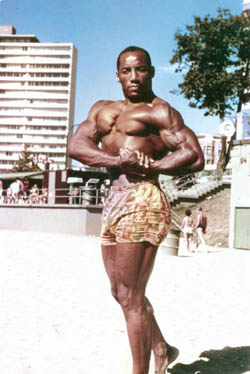
Earl Maynard in his prime.
Maynard’s opposition for the evening is another familiar name – Masa Saito of Japan. Saito was a former Olympian, representing his nation in freestyle wrestling at the 1964 Summer Olympics in Tokyo. Turning pro with Rikidozan’s Japan Pro Wrestling Association (JWA) soon after, Saito would hone his craft in Japan before moving stateside in 1958, with Northern California as a frequent home base. “America and American wrestlers taught me how to be a wrestler, how to work, how to be friends with the wrestlers, and a whole bunch of other things that they taught me; I took all of that back to Japan,” Saito recalled in 2009 after his induction to the Wrestling Observer Hall of Fame.
But while Saito is multiple time tag team, television, and state champion across the United States, he is best known for a boulder, a McDonald’s window in Waukesha, Wisconsin, and a two-year stay in prison with another Olympian-turned-wrestler, Ken Patera. But that’s a story for another day.
Muscle men were certainly in vogue in San Francisco in 1971, with Rocky Johnson, another mountain of a man, appearing in the semi-main as tag partner with Tony Parisi. Today, Rocky Johnson is best known as the father of Dwayne Johnson, a.k.a. The Rock – one of the biggest wrestling, acting, or just plain stars in the world today. He’s also well known for being the father of several other children, as told in this remarkable Sports Illustrated article by Greg Oliver.
Johnson teamed with Tony ‘Cannonball’ Parisi this evening. Parisi (Antonio Pugliese) was another in a long line of Italian-born grapplers who found fame in North America in the ’60s, joining the likes of fellow paisans Michel Leone, Bruno Sammartino, and Dominic Denucci (among others).
After a lengthy career, Pugliese bought the Niagara Family Inn in Niagara Falls and later opened a local restaurant and lounge called Big Anthony’s. He successfully ran his businesses and annual legends show in Buffalo until his death in 2000.
The team of Johnson and Parisi faced stiff competition in Kinji Shibuya and The Professional. Kinji Shibuya wasn’t just a popular “bad guy” in the Bay Area – he was THE bad guy. The Japanese heel was the quintessential foreign menace and the plight of local heroes – but Shibuya was neither foreign nor a menace.
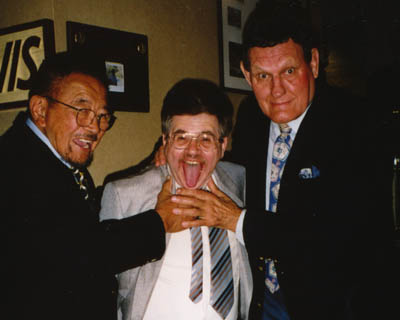
Kinji Shibuya, Tom Burke and Killer Kowalski.
Despite claiming to be from Japan in his career, Kinji Shibuya was really Robert Shibuya, a Utah-born football star who played for the University of Hawaii. The “evil” Kinji Shibuya character was carefully crafted in the early 1950s to feed on anti-Japanese sentiment, still running high after the Second World War. This brutish, nasty persona would enrage fans across the continent for a quarter of a century – and would lead his jump from the ring to the silver screen.
But the reality was far different. To friends in his Hayward, California neighborhood, where he lived from 1967 until his death, he was a kind, quiet, and caring family man. His later years saw the aging Shibuya raise champion koi carp and stroll his neighborhood with a pair of garden shears, trimming people’s shrubs and sparking friendly conversations.
“Back in the ’60s, he could walk into the fanciest restaurant in San Francisco and get seated right away,” said his son, Robert Shibuya, upon his father’s passing in 2010. “It was like he was Sinatra.”
Shibuya’s partner was “The Professional,” Doug Lindzy, who would also work as (the original) Doug Gilbert. Lindzy was from South Bend, Indiana, and had broken into the wrestling business after befriending wrestlers lifting weights at the gym in the old Marigold Arena in Chicago.
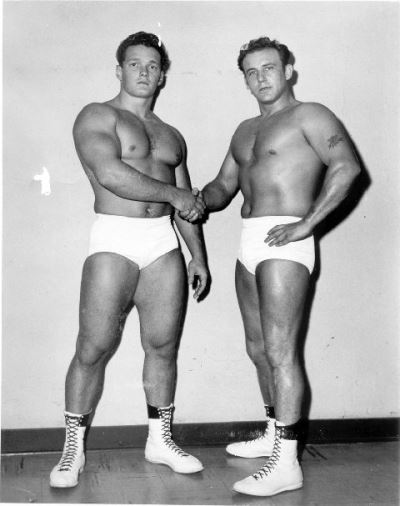
Dick Steinborn and Doug Gilbert.
Lindzy would spend much of his career in the Midwest, teaming with “brother” Johnny Gilbert (Gilbert Sanchez) as Doug Gilbert (no relation to Tommy, Eddie, or the other Doug). Several years before tonight’s card, he found his greatest success in the AWA as half of the popular tag team “Hi and Low” with Dick Steinborn. Steinborn was the mat technician of the pair (and thus, the “low” or “Mr. Low”). At the same time, Lindzy took care of the acrobatics (nicknamed “Mr. High”), thanks to a style reminiscent of one of the early “flippy-floppers,” Edouard Carpentier (Édouard Weiczorkiewicz).
And finally, we get to our main event and the reason for this installment: Pat Patterson and Billy Graham defending their tag team titles against former champions Peter Maivia and Ray Stevens.
Billy Graham was still a rookie in 1971, having started the business only a year earlier, under his real name, Wayne Coleman, for Stu Hart in Calgary. Hart, one of the greatest trainers in the sport’s history, had taken the former Golden Gloves and CFL player for the Montreal Alouettes and Calgary Stampeders and turned him into a wrestler. And while the skillset of Wayne Coleman was never exemplary, he had something undeniable that fans could gravitate towards right from the start.
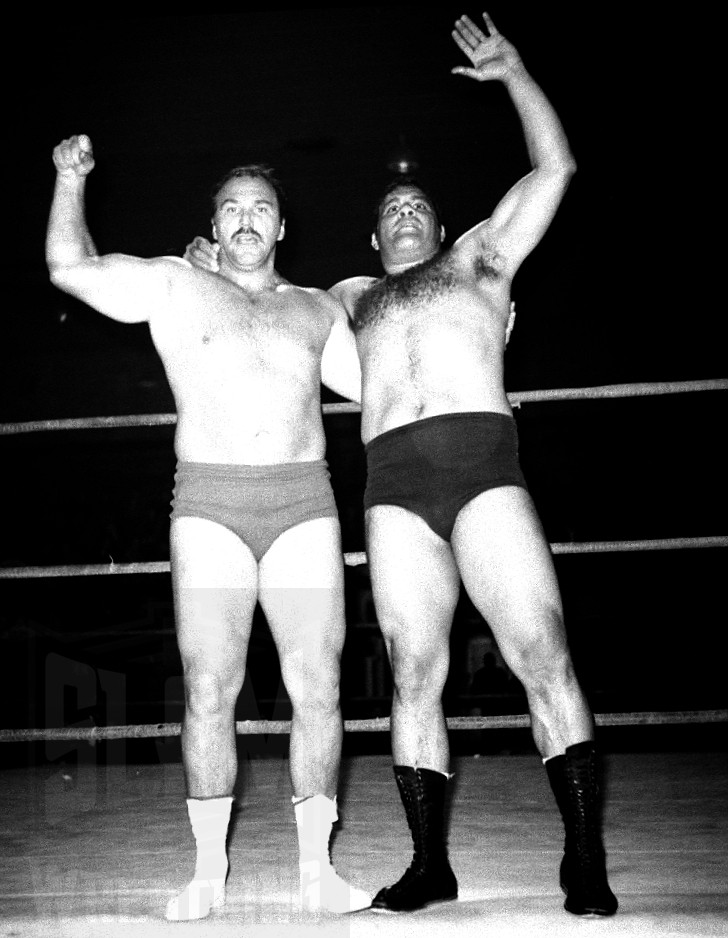
Wayne Coleman — the future Superstar Billy Grahama — and Angelo Mosca in a Stampede Wrestling ring. Photo by Bob Leonard
That “it” was Wayne Coleman’s phenomenal build. Standing 6-foot-4 and weighing 285 pounds, Coleman had a frame already big by professional wrestling standards. But his hulking muscles – the type to rival any physique in the history of wrestling – initially set him apart.
The next piece of the puzzle, a great character, was provided next, thanks to Dr. Jerry Graham. Graham (born Jerry Matthews) was already a legend in the wrestling business, having formed one of the most dominant tag teas in WWE history with “brother” Eddie (Ed Gossett). Together the team had won multiple US Tag Team Championships in Capitol Wrestling in the northeast, but by 1970 things were anything but “good” for the doctor.
You probably know a few Dr. Jerry Graham stories if you’ve read any autobiographies of the period. From dying a suit in the bathtub while wearing it, to abducting his mother’s corpse after his death, many stories about the “Good Doctor” are so far-fetched that they beggar belief. But they are true. By 1970, Dr. Jerry Graham was an outcast in the wrestling business due to his addiction and mental health struggles, with his career stagnating in Arizona.
But Dr. Jerry had an amazing mind for the business – and new hot to make (and blow) money. When the rookie Coleman entered the locker room, he knew his new meal ticket had arrived. Christening Coleman “Billy Graham” the future “Superstar.” The pair complemented each other’s style, with the young, muscular Graham providing realistic muscle for the crafty, portly, and likely sozzled Dr. Jerry.
While the partnership worked for a while, young Billy eventually set out to find fame, with his next stop being San Francisco for Roy Shire. Arriving in the Bay Area in October 1970, Graham was quickly paired with local star Pat Patterson, with the idea that the established Patterson could help boost the reputation of the very limited Billy Graham.
“He was my mentor for one full year in the San Francisco territory,” the Superstar recalled in a social media post after Patterson died in 2020. “He told me how to do my first blade job as his tag team partner. I forgot the name of the tag team championship belts we held.”
The duo held the San Francisco version of the world tag team championships, with Graham replacing the Gladiator (AKA Ricky Hunter, real name Charles Sprott) who had previously teamed with Patterson. The crafty Patterson, now a decade deep into his career, was the perfect mentor for Graham, helping him to establish a cocky, boastful demeanor that would eventually see him beat Bruno Sammartino for the WWWF Championship seven years later.
In tonight’s main event, the team of Patterson and Graham defended their tag team championship against Ray Stevens and Peter Maivia. The biggest thing that jumps out here is Patterson and Stevens in a tag match as opponents.
Ray Stevens (Carl Ray Stevens) Is probably the best-known wrestler from the Big Time Wrestling territory. Stevens was a dynamic performer who revolutionized the business with his flashy style, with his “Bombs Away” top rope knee drop the vogue move of the 1960s and ’70s. But his career spans back much further, with the West Virginia-born Stevens making a name for himself against the legendary “Gorgeous” George Wagner propelling him into the main events in the early 50s – at the age of 17.
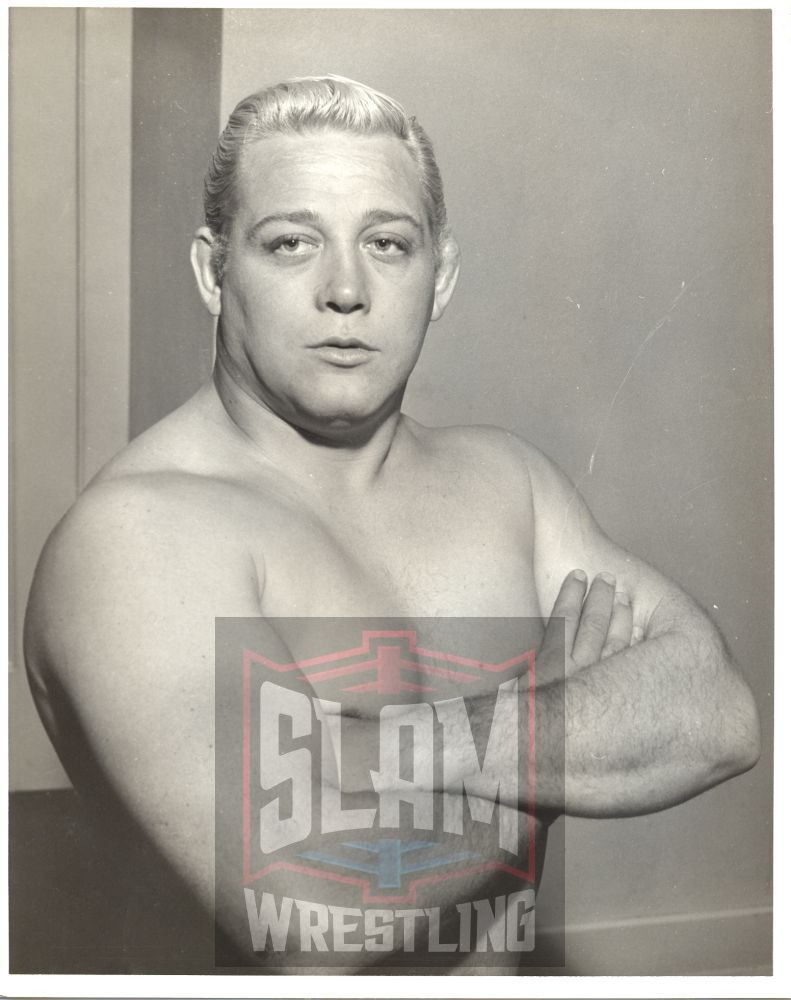
Ray Stevens in a promo photo that only went out to his fan club members.
Stevens would find his home in San Francisco, a popular attraction alongside his tag team partner, promoter Roy Shire, as fictional “brother” Ray Shire, one half of the “Blond Bombers.” He would become an exceedingly popular babyface and heel in the territory, winning every accolade available before switching to the AWA and later WWF at the end of his career.
By 1971, the Patterson and Stevens tag team that was the talk of wrestling had already won the World Tag Team Titles (San-Francisco-Version) on multiple occasions, with the two on the outs and feuding as the biggest stars in the territory. The Stevens and Maivia team would win the titles on the evening, taking two out of three falls.
Peter Maivia (Fanene Pita Maivia) was himself no slouch and was another popular Bay Area performer. Maivia is also the founder of a highly prolific wrestling clan – the famed Samoans with Afa and Sika (nephews), Peter Jr. (son), Tama, Rikishi, Roman Reigns, Samu, Matt Anoa’i, Yokozuna (all grandnephews) and countless others joining the professional ranks in subsequent years. Maivia was also the father-in-law of Rocky Johnson and the stepfather of Ata, Rocky’s wife, and the mother of Dwayne Johnson. Not a bad family tree, huh?
After losing the titles, Billy Graham and Pat Patterson drifted apart, with both enjoying tremendous success throughout the 1970s and early ’80s. But if Billy Graham owed much of his success to the early mentoring of Pat Patterson, it was a cherished relationship that he would throw away 20 years later.
“As most of you know, I said some very harsh untruths about him on the old Phil Donahue show,” Graham would recall in the same social media post after Patterson’s death. “Vince told me that he forgave me for those lies, but Patterson would never. And Vince was correct.”
The incident in question took place on the Phil Donahue Show in 1992 when Graham appeared with Vince McMahon, Dave Meltzer, John Arezzi, Bruno Sammartino, and Barry Orton to discuss the drugs and sex scandals that were rocking the WWF.
The sex scandal related to the abuse of underage ring crew members by Mel Phillips and other WWF personnel. Also present on the stage was Murray Hodgson, a one-time WWF announcer, who would later file a sexual harassment/wrongful termination lawsuit against the WWF/Titan Sports, Terry Garvin, and Pat Patterson.
The appearance and subsequent lawsuit painted Patterson negatively, despite no charges (or evidence) of any sexual impropriety emerging. To many on the inside, it seemed like Patterson was hounded because he was gay, with the long-time WWF executive and confidant to Vince McMahon taking a sabbatical later in the year. It was a time when Patterson struggled greatly, and he could never forget – or forgive those involved, like Billy Graham.
It’s easy to criticize Superstar Graham, as his actions that day (and subsequently) broke his friendship with Patterson – so much so that Patterson didn’t mention Graham once in his autobiography. But Wayne Coleman was human and owned his mistakes – even if they were born with good intentions against a business he saw as increasingly immoral and corrupt. Still, his political path through the wrestling world is something of a conundrum – perhaps that’s why his WWE-produced autobiography is subtitled Tangled Ropes.
Rest in peace, “Superstar”. Until next time.
RELATED LINKS
